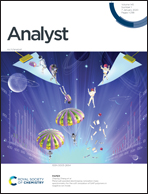Applications of hydrothermal synthesis of Escherichia coli derived carbon dots in in vitro and in vivo imaging and p-nitrophenol detection†
Abstract
Carbon dots (CDs) have broad prospective applications in various fields, and expanding the applications of fluorescent CDs, especially for CDs derived from bacteria, is a major research goal. In this study, novel CDs derived from Escherichia coli BW25113 (WT) were successfully synthesized via a one-step hydrothermal method. Unlike previously developed CDs-E. coli, CDs-WT can be used for microbial imaging of both live and dead cells. We demonstrated the biocompatibility, excellent penetrability, and nontoxic characteristics of CDs-WT for use as fluorescent probes for bioimaging both in vitro and in vivo. Importantly, we provide the first demonstration of CDs-WT distribution in various organs of mice, including the ability to cross the blood–brain barrier and the potential for rapid excretion through the intestines. Additionally, CDs-WT can be instantly utilized as a fluorescent probe for the highly selective and rapid detection of p-nitrophenol (p-NP) by the inner filter effect, with a limit of detection for p-NP of 11 nM, the lowest value reported to date. Hence, our results demonstrate the feasibility of p-NP detection and extend the bio-imaging applications of CDs prepared from bacteria.



 Please wait while we load your content...
Please wait while we load your content...